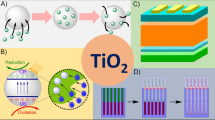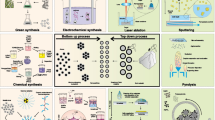Abstract
Hybrid organic–inorganic coatings showing photothermal activity and anti-bacterial properties were easily obtained by cross-linking of glycerol in presence of silane-coated silver NPs (Ag NPs). Ag NPs functionalized with aminosilane groups were prepared by reduction of AgNO3 with 3-aminopropyl trimethoxysilane (APTMS), by following a previously published procedure (dell’Erba et al., J Mater Sci 51:3817–3823, 2016), using glycerol as both reducing agent and solvent. Thermal treatment of these dispersions induced reaction between hydroxyl from glycerol and methoxysilane groups, producing a chemically resistant, cross-linked nanostructured network with covalently bonded Ag NPs. Control on the degree of glycerol release during synthesis enabled producing, in just one step, a cross-linked material with variable concentrations of Ag NPs. Tuning the annealing temperature and composition of the reactive samples allowed controlling the final concentration of NPs in the solid samples and the physicochemical properties of the coatings. Obtained materials showed an excellent chemical stability, bactericidal effect against Escherichia coli, and a significant photothermal effect. The simplicity of the procedure, the use of glycerol as monomer and solvent, and the high versatility of the strategy that enables the inclusion of different metals in a cross-linked matrix, make the synthetic strategy very promising for the development of materials with technological applications.

Graphical abstract









Similar content being viewed by others
References
Sun Y, Zhang Y, Shi Y, Xiao X, Dai H, Hu J, Ni P, Li Z (2013) Facile preparation of silver nanoparticle films as an efficient surface-enhanced Raman scattering substrate. Appl Surf Sci 283:52–57. https://doi.org/10.1016/j.apsusc.2013.05.154
Soliveri G, Ardizzone S, Yüksel S, Cialla-May D, Popp J, Schubert US, Hoeppener S (2016) Microwave-assisted silver nanoparticle film formation for SERS applications. J Phys Chem C 120:1237–1244. https://doi.org/10.1021/acs.jpcc.5b10833
Lu Y, Liu GL, Lee LP (2005) High-density silver nanoparticle film with temperature-controllable interparticle spacing for a tunable surface enhanced Raman scattering substrate. Nano Lett 5:5–9. https://doi.org/10.1021/nl048965u
Teerasong S, Sani M, Numsawat P, Martchoo R, Chompoosor A, Nacapricha D (2015) A silver nanoparticle thin film modified glass substrate as a colourimetric sensor for hydrogen peroxide. J Exp Nanosci 10:1327–1335. https://doi.org/10.1080/17458080.2015.1007097
Chen R, Morris HR, Whitmore PM (2013) Fast detection of hydrogen sulfide gas in the ppmv range with silver nanoparticle films at ambient conditions. Sensors Actuators B Chem 186:431–438. https://doi.org/10.1016/j.snb.2013.05.075
James JZ, Lucas D, Koshland CP (2012) Gold nanoparticle films as sensitive and reusable elemental mercury sensors. Environ Sci Technol 46:9557–9562. https://doi.org/10.1021/es3005656
Pfeiffer TV, Ortiz-Gonzalez J, Santbergen R, Tan H, Ott AS, Zeman M, Smets AHM (2014) Plasmonic nanoparticle films for solar cell applications fabricated by size-selective aerosol deposition. Energy Procedia 60:3–12. https://doi.org/10.1016/j.egypro.2014.12.335
Sun C, Su J, Wang X (2015) A design of thin film silicon solar cells based on silver nanoparticle arrays. Plasmonics 10:633–641. https://doi.org/10.1007/s11468-014-9849-2
Dehnavi AS, Aroujalian A, Raisi A, Fazel S (2013) Preparation and characterization of polyethylene/silver nanocomposite films with antibacterial activity. J Appl Polym Sci 127:1180–1190. https://doi.org/10.1002/app.37594
Galya T, Sedlařík V, Kuřitka I et al (2008) Antibacterial poly(vinyl alcohol) film containing silver nanoparticles: preparation and characterization. J Appl Polym Sci 110:3178–3185. https://doi.org/10.1002/app.28908
Kanmani P, Rhim J-W (2014) Physicochemical properties of gelatin/silver nanoparticle antimicrobial composite films. Food Chem 148:162–169. https://doi.org/10.1016/j.foodchem.2013.10.047
Adepu S, Khandelwal M (2018) Broad-spectrum antimicrobial activity of bacterial cellulose silver nanocomposites with sustained release. J Mater Sci 53:1596–1609. https://doi.org/10.1007/s10853-017-1638-9
Sun B, Sun S, Li T, Zhang W (2007) Preparation and antibacterial activities of Ag-doped SiO2–TiO2 composite films by liquid phase deposition (LPD) method. J Mater Sci 42:10085–10089. https://doi.org/10.1007/s10853-007-2109-5
Choi B, Lee H-H, Jin S, Chun S, Kim SH (2007) Characterization of the optical properties of silver nanoparticle films. Nanotechnology 18:075706. https://doi.org/10.1088/0957-4484/18/7/075706
Budhiraja N, Sharma A, Dahiya S, Parmar R, Vidyadharan V (2013) Synthesis and optical characteristics of silver nanoparticles on different substrates. Int Lett Chem Phys Astron 19:80–88. https://doi.org/10.18052/www.scipress.com/ILCPA.19.80
Govorov AO, Richardson HH (2007) Generating heat with metal nanoparticles. Nano Today 2:30–38. https://doi.org/10.1016/S1748-0132(07)70017-8
Yue K, Nan J, Zhang X, Tang J, Zhang X (2016) Photothermal effects of gold nanoparticles induced by light emitting diodes. Appl Therm Eng 99:1093–1100. https://doi.org/10.1016/j.applthermaleng.2016.01.077
Zvyagina AI, Ezhov AA, Ivanov VK, Arslanov VV, Kalinina MA (2015) Highly tunable plasmonic assemblies of gold nanoparticles: in-plane manipulation of plasmon coupling with nanometer precision. J Mater Chem C 3:11801–11805. https://doi.org/10.1039/C5TC02300A
Qin Z, Wang Y, Randrianalisoa J, Raeesi V, Chan WCW, Lipiński W, Bischof JC (2016) Quantitative comparison of photothermal heat generation between gold nanospheres and nanorods. Sci Rep 6:29836. https://doi.org/10.1038/srep29836
Altuna FI, Antonacci J, Arenas GF, Pettarin V, Hoppe CE, Williams RJJ (2016) Photothermal triggering of self-healing processes applied to the reparation of bio-based polymer networks. Mater Res Exp 3:045003. https://doi.org/10.1088/2053-1591/3/4/045003
Leonardi AB, Puig J, Antonacci J, Arenas GF, Zucchi IA, Hoppe CE, Reven L, Zhu L, Toader V, Williams RJJ (2015) Remote activation by green-light irradiation of shape memory epoxies containing gold nanoparticles. Eur Polym J 71:451–460. https://doi.org/10.1016/j.eurpolymj.2015.08.024
Chang C, Yang C, Liu Y, Tao P, Song C, Shang W, Wu J, Deng T (2016) Efficient solar-thermal energy harvest driven by interfacial plasmonic heating-assisted evaporation. ACS Appl Mater Interfaces 8:23412–23418. https://doi.org/10.1021/acsami.6b08077
Liu Z, Yang Z, Huang X, Xuan C, Xie J, Fu H, Wu Q, Zhang J, Zhou X, Liu Y (2017) High-absorption recyclable photothermal membranes used in a bionic system for high-efficiency solar desalination via enhanced localized heating. J Mater Chem A 5:20044–20052. https://doi.org/10.1039/C7TA06384A
Kim SH, Kang EB, Jeong CJ, Sharker SM, in I, Park SY (2015) Light controllable surface coating for effective photothermal killing of bacteria. ACS Appl Mater Interfaces 7:15600–15606. https://doi.org/10.1021/acsami.5b04321
Jiang G, Chen L, Zhang S, Huang H (2018) SuperhydrophobicSiC/CNTs coatings with photothermal deicing and passive anti-icing properties. ACS Appl Mater Interfaces 10:36505–36511. https://doi.org/10.1021/acsami.8b11201
Yin X, Zhang Y, Wang D, Liu Z, Liu Y, Pei X, Yu B, Zhou F (2015) Integration of self-lubrication and near-infrared photothermogenesis for excellent anti-icing/deicing performance. Adv Funct Mater 25:4237–4245. https://doi.org/10.1002/adfm.201501101
Dash S, de Ruiter J, Varanasi KK (2018) Photothermal trap utilizing solar illumination for ice mitigation. Sci Adv 4:eaat0127. https://doi.org/10.1126/sciadv.aat0127
Zhang D, Toh GW, Lin H, Chen Y (2012) In situ synthesis of silver nanoparticles on silk fabric with PNP for antibacterial finishing. J Mater Sci 47:5721–5728. https://doi.org/10.1007/s10853-012-6462-7
Sondi I, Salopek-Sondi B (2004) Silver nanoparticles as antimicrobial agent: a case study on E. coli as a model for Gram-negative bacteria. J Colloid Interface Sci 275:177–182. https://doi.org/10.1016/j.jcis.2004.02.012
Duncan TV (2011) Applications of nanotechnology in food packaging and food safety: barrier materials, antimicrobials and sensors. J Colloid Interface Sci 363:1–24. https://doi.org/10.1016/j.jcis.2011.07.017
Adawi HI, Newbold MA, Reed JM, Vance ME, Feitshans IL, Bickford LR, Lewinski NA (2018) Nano-enabled personal care products: current developments in consumer safety. NanoImpact 11:170–179. https://doi.org/10.1016/j.impact.2018.08.002
Boyle D, Goss GG (2018) Effects of silver nanoparticles in early life-stage zebrafish are associated with particle dissolution and the toxicity of soluble silver. NanoImpact 12:1–8. https://doi.org/10.1016/j.impact.2018.08.006
Pol VG, Srivastava DN, Palchik O, Palchik V, Slifkin MA, Weiss AM, Gedanken A (2002) Sonochemical deposition of silver nanoparticles on silica spheres. Langmuir 18:3352–3357. https://doi.org/10.1021/la0155552
Perkas N, Amirian G, Applerot G, Efendiev E, Kaganovskii Y, Ghule AV, Chen BJ, Ling YC, Gedanken A (2008) Depositing silver nanoparticles on/in a glass slide by the sonochemical method. Nanotechnology 19:435604. https://doi.org/10.1088/0957-4484/19/43/435604
Karakouz T, Maoz BM, Lando G, Vaskevich A, Rubinstein I (2011) Stabilization of gold nanoparticle films on glass by thermal embedding. ACS Appl Mater Interfaces 3:978–987. https://doi.org/10.1021/am100878r
Hu M, Yamaguchi Y, Okubo T (2005) Self-assembly of water-dispersed gold nanoparticles stabilized by a thiolated glycol derivative. J Nanopart Res 7:187–193. https://doi.org/10.1007/s11051-004-4826-x
dell’Erba IE, Hoppe CE, Williams RJJ (2012) Films of covalently bonded gold nanoparticles synthesized by a sol–gel process. J Nanopart Res 14:1098–1105. https://doi.org/10.1007/s11051-012-1098-8
Liu Y, Plate P, Hinrichs V, Köhler T, Song M, Manley P, Schmid M, Bartsch P, Fiechter S, Lux-Steiner MC, Fischer CH (2017) Size- and density-controlled deposition of Ag nanoparticle films by a novel low-temperature spray chemical vapour deposition method—research into mechanism, particle growth and optical simulation. J Nanopart Res 19:141. https://doi.org/10.1007/s11051-017-3834-6
Rhim J-W, Wang L-F, Lee Y, Hong S-I (2014) Preparation and characterization of bio-nanocomposite films of agar and silver nanoparticles: laser ablation method. Carbohydr Polym 103:456–465. https://doi.org/10.1016/j.carbpol.2013.12.075
Prevo BG, Fuller JC, Velev OD (2005) Rapid deposition of gold nanoparticle films with controlled thickness and structure by convective assembly. Chem Mater 17:28–35. https://doi.org/10.1021/cm0486621
Schneid AC, Pereira MB, Horowitz F et al (2015) Silver nanoparticle thin films deposited on glass surface using an ionic silsesquioxane as stabilizer and as crosslinking agent. J Braz Chem Soc 26:1004–1012. https://doi.org/10.5935/0103-5053.20150066
Toor A, So H, Pisano AP (2017) Improved dielectric properties of polyvinylidene fluoride nanocomposite embedded with poly(vinylpyrrolidone)-coated gold nanoparticles. ACS Appl Mater Interfaces 9:6369–6375. https://doi.org/10.1021/acsami.6b13900
Xu Y, Konrad MP, Trotter JL, McCoy CP, Bell SEJ (2017) Rapid one-pot preparation of large freestanding nanoparticle-polymer films. Small 13:1602163. https://doi.org/10.1002/smll.201602163
Ma Z, Jiang Y, Xiao H, Jiang B, Zhang H, Peng M, Dong G, Yu X, Yang J (2018) Sol-gel preparation of Ag-silica nanocomposite with high electrical conductivity. Appl Surf Sci 436:732–738. https://doi.org/10.1016/j.apsusc.2017.12.101
Pileni M (ed) (2005) Nanocrystals forming mesoscopic structures. Wiley-VCH, Weinheim
Hood M, Mari M, Muñoz-Espí R (2014) Synthetic strategies in the preparation of polymer/inorganic hybrid nanoparticles. Materials 7:4057–4087. https://doi.org/10.3390/ma7054057
Balazs AC, Emrick T, Russell TP (2006) Nanoparticle polymer composites: where two small worlds meet. Science 314:1107–1110. https://doi.org/10.1126/science.1130557
Jancar J, Douglas JF, Starr FW, Kumar SK, Cassagnau P, Lesser AJ, Sternstein SS, Buehler MJ (2010) Current issues in research on structure–property relationships in polymer nanocomposites. Polymer 51:3321–3343. https://doi.org/10.1016/j.polymer.2010.04.074
Krishnamoorti R (2007) Strategies for dispersing nanoparticles in polymers. MRS Bull 32:341–347. https://doi.org/10.1557/mrs2007.233
Zhang H, Han J, Yang B (2010) Structural fabrication and functional modulation of nanoparticle-polymer composites. Adv Funct Mater 20:1533–1550. https://doi.org/10.1002/adfm.201000089
Pagliaro M (2017) Glycerol. In: Glycerol. Elsevier, pp 109–132
Kong PS, Aroua MK, Daud WMAW (2016) Conversion of crude and pure glycerol into derivatives: a feasibility evaluation. Renew Sust Energ Rev 63:533–555. https://doi.org/10.1016/j.rser.2016.05.054
Hejna A, Kosmela P, Formela K, Piszczyk Ł, Haponiuk JT (2016) Potential applications of crude glycerol in polymer technology–current state and perspectives. Renew Sust Energ Rev 66:449–475. https://doi.org/10.1016/j.rser.2016.08.020
Monteiro MR, Kugelmeier CL, Pinheiro RS, Batalha MO, da Silva César A (2018) Glycerol from biodiesel production: technological paths for sustainability. Renew Sust Energ Rev 88:109–122. https://doi.org/10.1016/j.rser.2018.02.019
Leoneti AB, Aragão-Leoneti V, de Oliveira SVWB (2012) Glycerol as a by-product of biodiesel production in Brazil: alternatives for the use of unrefined glycerol. Renew Energy 45:138–145. https://doi.org/10.1016/j.renene.2012.02.032
dell’Erba IE, Mansilla AY, Hoppe CE, Williams RJJ (2016) Synthesis and characterization of an antibacterial powder based on the covalent bonding of aminosilane-stabilized silver nanoparticles to a colloidal silica. J Mater Sci 51:3817–3823. https://doi.org/10.1007/s10853-015-9700-y
Lin-Vien D, Colthup NB, Fateley WG, Grasselli JG (1991) The handbook of infrared and raman characteristic frequencies of organic molecules. Academic Press, Boston
Socrates G (2001) Infrared and Raman characteristic group frequencies: tables and charts3rd edn. Wiley, Chichester
Lv Y, Liu H, Wang Z, Liu S, Hao L, Sang Y, Liu D, Wang J, Boughton RI (2009) Silver nanoparticle-decorated porous ceramic composite for water treatment. J Membr Sci 331:50–56. https://doi.org/10.1016/j.memsci.2009.01.007
Patterson AL (1939) The Scherrer formula for X-ray particle size determination. Phys Rev 56:978–982. https://doi.org/10.1103/PhysRev.56.978
Langford JI, Wilson AJC (1978) Scherrer after sixty years: a survey and some new results in the determination of crystallite size. J Appl Crystallogr 11:102–113. https://doi.org/10.1107/S0021889878012844
Funding
This work was financially supported by the National Research Council (CONICET), the University of Mar del Plata, and the National Agency for the Promotion of Science and Technology (ANPCyT), Argentina (PICT15-1433).
Author information
Authors and Affiliations
Contributions
The manuscript was written through contributions of all authors. All authors have given approval to the final version of the manuscript.
Corresponding author
Ethics declarations
Conflict of interest
The authors declare that they have no competing interest.
Additional information
Publisher’s note
Springer Nature remains neutral with regard to jurisdictional claims in published maps and institutional affiliations.
Rights and permissions
About this article
Cite this article
Cativa, N.M., Mansilla, A.Y., Arenas, G.F. et al. The use of glycerol as reactive solvent in the one-pot synthesis of antibacterial hybrid organic–inorganic coatings with photothermal activity. Colloid Polym Sci 297, 749–761 (2019). https://doi.org/10.1007/s00396-019-04490-w
Received:
Revised:
Accepted:
Published:
Issue Date:
DOI: https://doi.org/10.1007/s00396-019-04490-w




